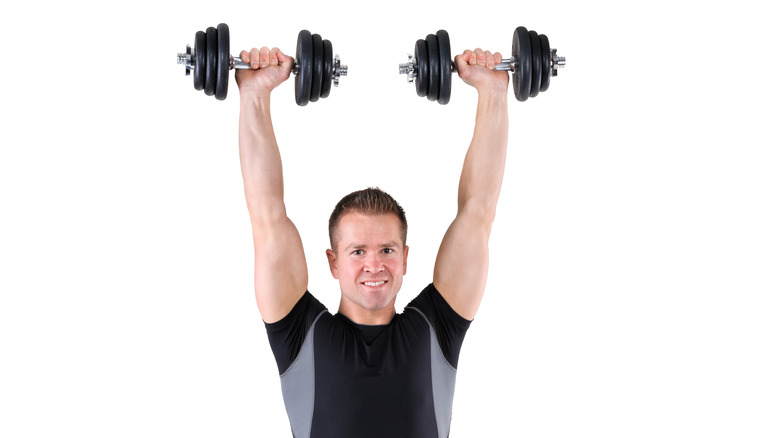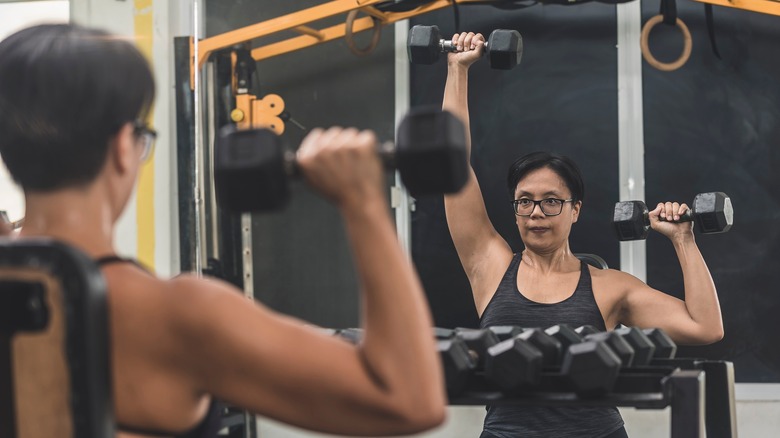The Proper Way To Do A Dumbbell Overhead Press
Strong shoulders look great in a tank top, but your shoulders also help you with your posture and with everyday movements such as reaching for something on a shelf. While the shoulder is quite mobile, it's also less stable than other joints, and is prone to injuries of the rotator cuff (via ShareCare). The dumbbell overhead press (also called the shoulder press) recruits many muscles in the shoulders while helping to correct any muscular imbalances in your shoulders that might occur from being hunched over at your desk for long periods of time (via BoxRox).
Although the primary muscles worked in the overhead dumbbell press are the anterior, lateral, and posterior deltoids, you'll also be working your triceps, pectorals, and trapezius (per Steel Supplements). Because you're standing during these exercises, your abdominals and glutes will be firing to keep you stable throughout the movement. Unlike a machine overhead press, the dumbbell shoulder press also doesn't allow you to "cheat" because each arm must work independently to drive the weight up. To avoid injury, it's important to do the dumbbell shoulder press with proper form.
The proper form of a dumbbell overhead press
First, it's best to check your shoulder mobility. While standing, raise your arms overhead. If your biceps don't line up with your ears, it's best to work on your mobility first (or do this move without weights) before trying the dumbbell overhead press (via Healthline).
Start with holding the dumbbells at neck level with your palms facing away from you, according to the International Sports Science Association (ISSA). Your arms and elbows might point out slightly, but avoid having them so far from your midline that they're perpendicular to your body. If your elbows are flared out too much, you'll put too much strain on your rotator cuff.
Plant your feet a little wider than hip-width, and avoid locking out your knees. Your spine should have a natural curve. If you're arching your back, it means your dumbbells are too heavy. Exhale as you drive the dumbbells over your head, and inhale as you control the weight down. Avoid doing this movement too quickly or using explosive movements — these could cause shoulder injury.
Variations of the dumbbell overhead press
To avoid injury, the ISSA suggests using lighter weights and taking care to follow proper form for the dumbbell overhead press. As you progress you can add more weight or try lifting one dumbbell at a time. This will make your core work a little more to keep you stable. You can also vary your grip to work your shoulder muscles a little differently. Try using a hammer grip, which is holding the dumbbells with your palms facing one another. You can also work in an isometric strengthener by pausing the dumbbells at the top of the movement.
ISSA also suggests adding some other movements to your dumbbell overhead press to work other muscles. An Arnold press starts with a dumbbell bicep curl, then at the top of the bicep curl, flip your wrists and do a shoulder press. You can work your legs in a dumbbell overhead press by starting in a squat position and driving through your butt, quads, and hamstrings while pressing the dumbbells overhead. You can also work on your shoulder mobility by holding a kettlebell upside down for your shoulder press. The instability of the kettlebell will cause you to use your shoulder stabilizers (via Healthline).



